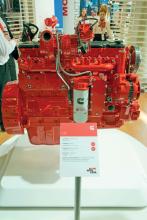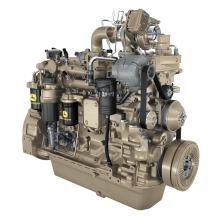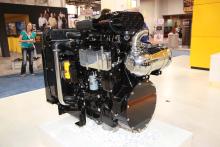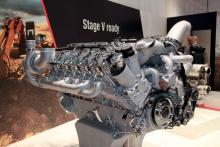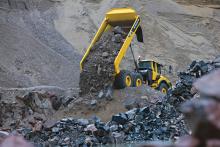
With many engine makers announcing they can already meet the expected Stage V emissions regulations, attention could finally start to shift towards performance, productivity and efficiency in other powertrain areas. Geoff Ashcroft reports.
With EU Stage V emissions regulations on the horizon, and many engine makers confident of meeting the expected legislation, there could soon be a revised focus of attention that sees powertrain efficiency making big strides forward. Many are already starting to turn their attention – and perhaps their R&D budgets - towards energy-diverse powertrain technology solutions.
Such confidence has enabled the company to look ahead to the next generation of powertrain solutions including clean diesel, near-zero natural gas and electric power solutions. The latter is an area that has taken on greater significance with Cummins’ recent acquisition of battery-expertise company Bremmo.
As a result, the firm has already revealed a new powertrain solution for use in full battery electric vehicles (BEV) and range-extended electric vehicles (REEV) – the latter incorporating a compact engine-generator.
Currently, these powertrains are suited to shuttle and commuter buses, but offer scope for integration into a diverse range of applications and industries seeking greater operating efficiency from zero-emissions vehicles.
Each standard-size Cummins battery enclosure provides a 70kWh storage capability. In the BEV application, a total of eight battery enclosures are linked to provide 560kWh of power giving a zero emissions range of 224 miles on a single charge.
The REEV application uses three battery enclosures offering 210kWh and a range of 84 miles. As the battery packs deplete to a low state of charge, the vehicle calls upon its 201hp engine-generator to recharge the batteries while continuing to operate with ultra-low emissions capability.
Regenerative braking adds to stored battery power, and electrical energy can be used for vehicle accessories such as air conditioning, power steering and cooling fans.
Advanced electronics on the current engine line-up has simplified the introduction of data management and connectivity, boosting telematics capabilities. This allows operators to check component status, fuel consumption, machine use and service requirements.
Cummins’ solution is the Guidanz App – an Android and Apple iOS compatible data analytic app to provide remote reading of fault codes.
This app can also be synchronised with an electronic oil cap that Perkins is set to introduce, which cleverly monitors engine hours through vibration frequencies. Available for use on engines from the compact 0307 engine up to the 1206 series, it feeds data directly to the Perkins My engine app when the user is within Bluetooth range of the engine.
The firm has also announced that it is the first engine maker to be given an EU Stage V certificate, which is currently applicable to its TTCD6.1 engine. And its Stage V engine portfolio is set to grow in 2019 with four new additional in-line engines offering capacities from nine to 18litres.
The TCD 18.0 will head-up the range, with power from this all-new six-cylinder engine reaching 620kW and 3,600Nm of torque, and this new power unit is said to be targeted at heavy construction equipment with high power and torque demands.
In addition, Deutz has taken a step closer to the world of electrification, having acquired German electric drive specialist Torqeedo. As part of its E-Deutz strategy, the German engine maker intends to extend its operations to include the development and manufacture of hybrid and all-electric drive system solutions for off-highway applications.
John Deere Power Systems (JDPS) has turned to new catalyst technologies, emission control calibrations and the next generation of after-treatment solutions to deliver greater package flexibility and easier installation with its EU Stage V compliant engines.
The JDPS line-up of Stage V power units extends from 36-448kW from a range of 2.9litre, 4.5litre, 6.8litre, 9.0litre and 13.5litre engines.
JDPS said OEM’s are likely to benefit from its continual product improvement that has seen engine performance retained but in a much smaller and lighter package. Typically, this adds up to a 39% reduction in size and a 57% reduction in weight – most of which has come from revised after-treatment solutions.
The firm said its Stage V solution has an exhaust temperature that is lower than the average of many other competitor solutions on the market, stating that a lower exhaust temperature suits those operating environments where higher exhaust temperatures can have particular health and safety implications.
Volvo Penta adds that its Stage V engines and exhaust after-treatment packages are designed to work together to maximise passive regeneration during normal operation. There is no high-temperature regeneration, because the sulphur regeneration in the SCR catalyst is not required – and only soot regeneration is needed to clean the DPF.
It represents the third engine line for the British maker since production started at JCB Power Systems in Derbyshire, and joins the 4.4, 4.8 and 7.2litre models.
Called the JCB430 DieselMax, it is said to offer an 8% reduction in fuel use over the 4.4litre EcoMax, while being 30% lighter. It meets existing emissions regulations without the need for DPF, SCR or DOC, and is said to be ready for Stage V emissions standards and will eventually be offered with additional power ratings.
The firm says engine mounting interfaces are shared with those of its larger 4.4 and 4.8litre power units, enabling simple installation in existing JCB-powered equipment.
But diesel is not the only fuel choice available for off-highway power units, and FPT has already hinted at what might be coming over the horizon based on its on-highway experiences with truck maker
And that is because the firm has created the Cursor 13 NP to power the Stralis model in Iveco’s heavy truck range. This 343kW ‘natural power’ engine is one that is based on the 13-litre diesel-fuelled Cursor 13 power unit, but it has been re-engineered into a spark ignition engine – identical to the operating principles of a petrol-powered engine.
FPT claims it is a direct match for the 343kW diesel-powered Cursor 13 engine, though the NP version brings much lower running costs, simpler maintenance, lower noise levels and near-zero emissions.
It can be fuelled by either liquefied natural gas (LNG) or compressed natural gas (CNG). Importantly, neither of these fuels require a DPF, DOC, cooled EGR or the addition of an exhaust after-treatment catalyst, which dramatically simplifies the engine architecture and installation. The only external addition to the engine is a three-way exhaust catalyst, similar to that found on a petrol engine, and dealing with carbon monoxide produced from the fuel burn.
FPT has already had a lot of success with the smaller capacity, and lower powered Cursor 9 NP engine. The arrival of the 13-litre has finally put the gas-powered engines on a par with their diesel counterparts.
Operating temperatures are typically 30% higher than the diesel engine, so FPT has given the Cursor 13 NP a new cylinder head constructed of graphite iron to help valve and valve seat lubricity. It also gains a revised exhaust manifold and turbocharger – the latter getting ball bearings and a water-cooled core.
The NP engine also uses multi-point fuel injection, feeding gas directly into each cylinder, on the back of the intake valve.
However, there are challenges for operators concerning the accessibility of the two fuels, and the practicality of storing fuel on-site. LNG is cryogenic and its -160oC liquefied state requires storage within insulated tanks at nine bars pressure. CNG on the other hand is stored in high pressure vessels from 20-200 bars.

